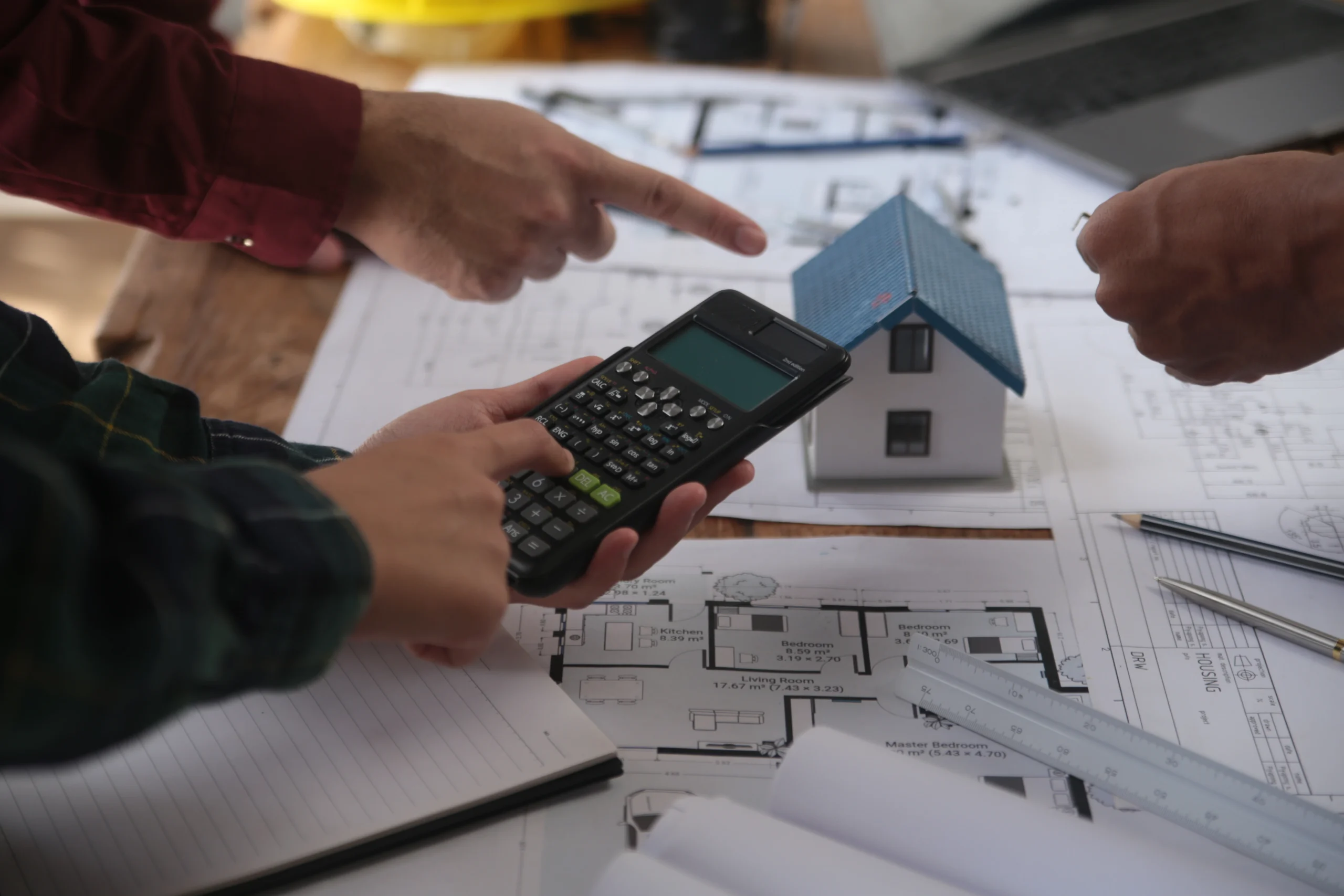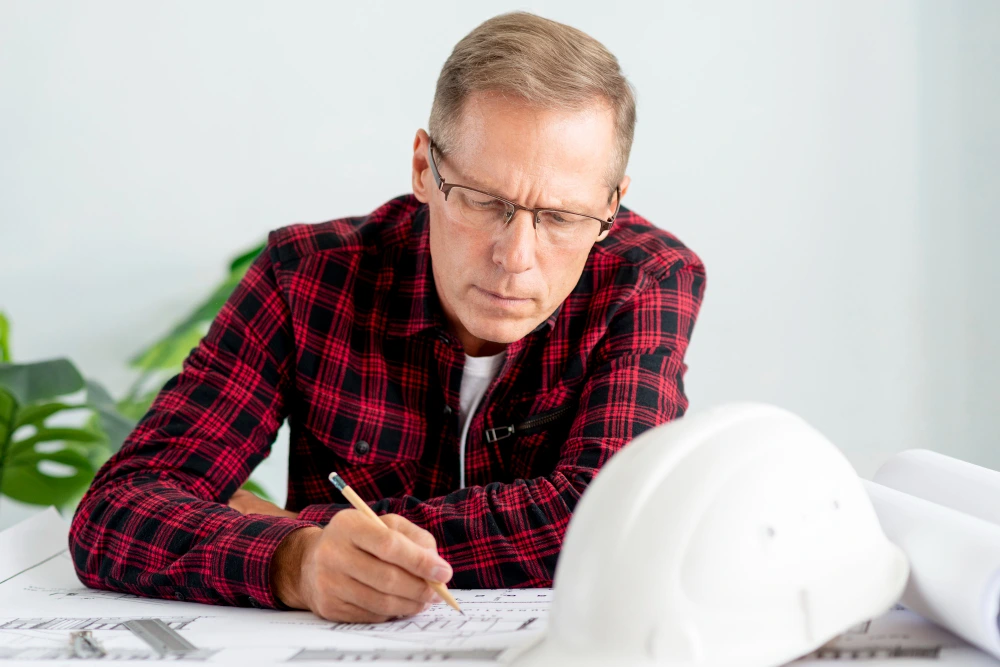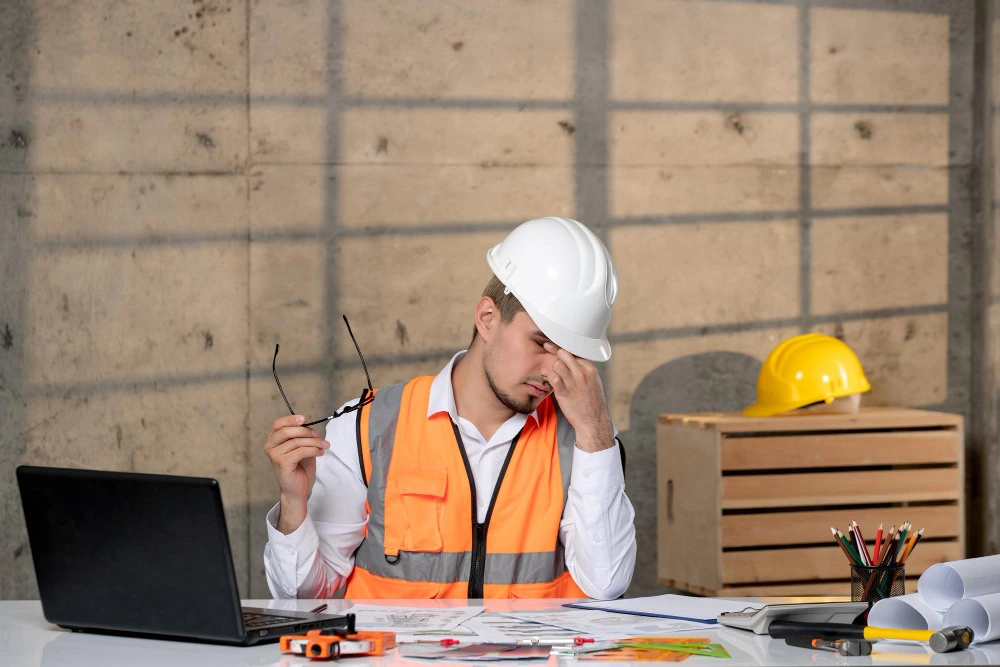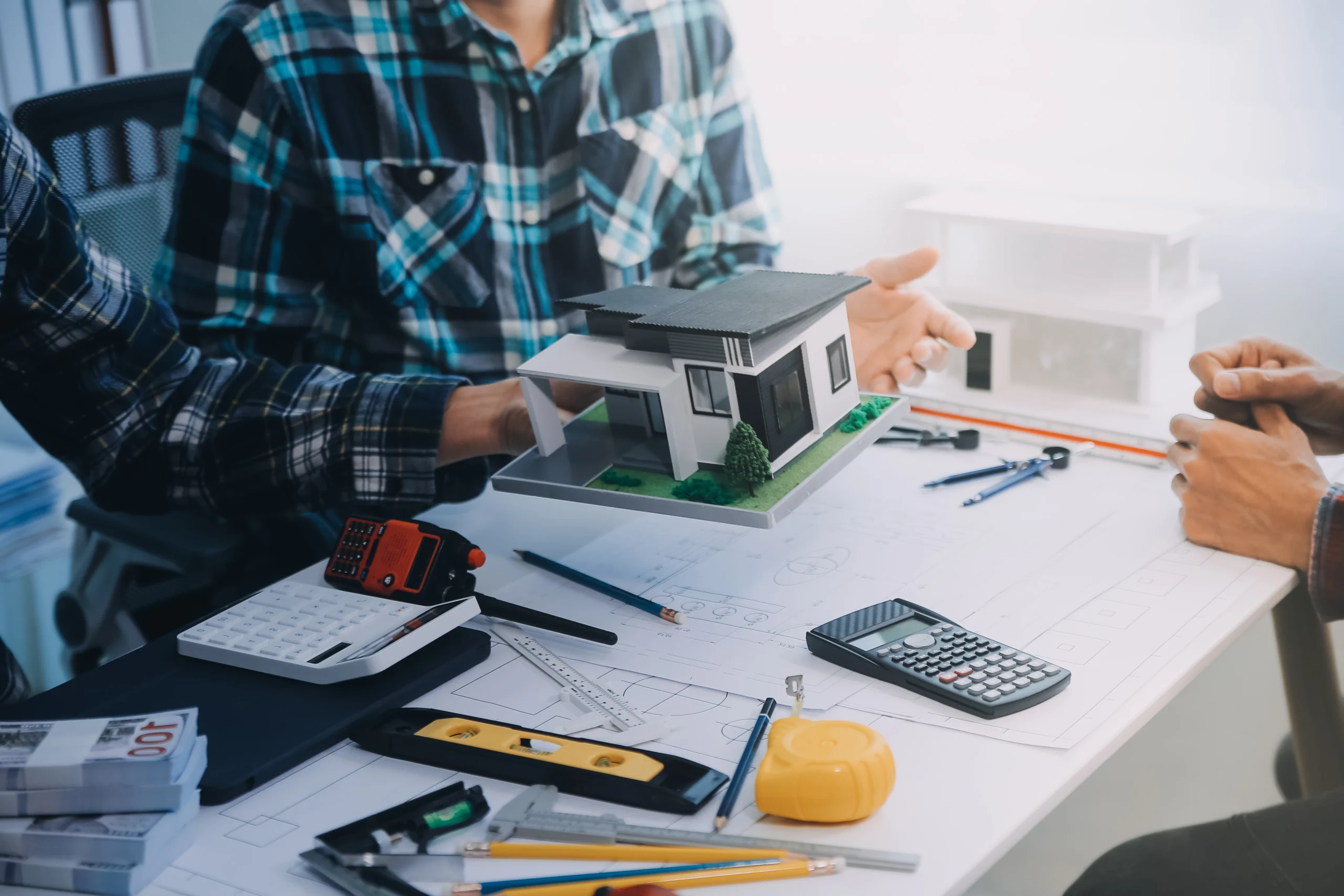Cost to Build a House in USA 2025
In 2025, the cost to build a home in the U.S. is shaped by fluctuating material prices, skilled labor availability, and evolving building codes. Whether you’re a homeowner, contractor, or developer, knowing the current cost per square foot is essential to budgeting, estimating, and avoiding costly surprises. From land prep and foundation to finishes and final inspection, every phase influences your total cost.
As a professional construction estimator with years of experience providing detailed cost breakdowns and takeoff services, I’ve seen firsthand how critical early and accurate estimating is essential for a successful project.
Key Insights
Quick Takeaway: Expect to pay anywhere between $150 to $300 per sq ft, depending on materials, location, and whether you’re managing the build yourself or hiring a general contractor.
Average Cost to Build a House by Square Foot in the USA
Understanding the cost per square foot to build a house is one of the first—and most important—steps in developing a construction budget. In 2025, construction costs continue to be shaped by inflation, supply chain adjustments, and regional labor dynamics. Whether you’re building a modest 1,000 sq ft starter home or a spacious 2,000 sq ft family house, accurate estimation is the key to avoiding budget overruns.
As professional estimators, we’ve helped hundreds of clients turn rough ideas into actionable numbers with detailed construction takeoff services. Below is a realistic, data-backed breakdown for 2025.
National Cost Per Sq Ft Overview 2025
In 2025, the national average cost to build a home ranges from $150 to $300 per square foot, depending on several factors:
- Material selection (basic vs luxury finishes)
- Labor rates in your region
- Contractor markup
- Site conditions and local regulations
Cost Factors That Influence Per Sq Ft Price
- Foundation type (slab, crawlspace, basement)
- Framing complexity
- HVAC, plumbing, and electrical systems
- Energy-efficient materials and green building codes
Pro Insight: In areas like the Midwest or South, you may see costs closer to $150–$180 per sq ft, while major metros like Los Angeles or NYC often exceed $250–$300 per sq ft, especially with high labor demand and strict building codes.
Regional Price Differences (Urban vs Rural)
Home construction costs vary widely between urban, suburban, and rural settings. Here’s why:
- Urban Areas
- Higher labor costs due to union rates or labor shortages
- Costlier permits and regulatory fees
- Space limitations increase site prep and logistics costs
- Rural Areas
- More affordable land and labor
- Longer transport times for materials
- Fewer inspectors, but fewer service providers may increase subcontractor premiums
Regional Cost Snapshot:
| Region | Cost per Sq Ft (2025) |
| Northeast | $200 – $300 |
| Midwest | $150 – $220 |
| South | $140 – $200 |
| West Coast | $220 – $320 |
| Mountain States | $170 – $250 |
Real-World Tip: A client building a 1,500 sq ft home in Ohio saved over $35,000 compared to a similar build in Denver—simply due to differences in land prep, subcontractor rates, and energy compliance requirements.
Pricing Table for 1,000, 1,500, and 2,000 Sq Ft Homes
Here’s a simplified estimate table for standard home sizes, assuming mid-range materials and basic site conditions:
| Home Size | Low-End Build ($150/sq ft) | Mid-Range Build ($200/sq ft) | High-End Build ($300/sq ft) |
| 1,000 sq ft | $150,000 | $200,000 | $300,000 |
| 1,500 sq ft | $225,000 | $300,000 | $450,000 |
| 2,000 sq ft | $300,000 | $400,000 | $600,000 |
Estimator Note: These numbers don’t include land costs, impact fees, or architectural services. For a truly accurate budget, always start with a professional takeoff service that considers your site conditions, zoning, and desired finish level.
Why Use Takeoff Services for Accurate Budgeting?
A construction takeoff isn’t just a materials list — it’s a cost-saving, risk-reducing tool. By outsourcing your takeoff and estimate:
- You eliminate guesswork and pricing gaps.
- You receive line-item precision in labor and materials.
- You can secure competitive bids from contractors based on actual needs.
- You reduce change orders and mid-project financial surprises.
Case Example: A Florida-based homeowner reached out utopiantakeoffs for their takeoff and discovered $18,000 in overlooked framing costs and permit fees. We foresight helped them reallocate funds early—before construction began.
Cost Breakd
own by House Size
Home size plays a direct role in the total construction cost—but square footage isn’t the only factor. Layout efficiency, number of bathrooms, exterior finishes, and local permit requirements also impact your final price. Whether you’re building a compact accessory dwelling unit (ADU) or a fully customized family home, understanding realistic costs is very crucial for construction planning.
Let’s explore cost ranges and layout ideas for 1,000, 1,500, and 2,000 sq ft homes in 2025.
Cost to Build a 1,000 Sq Ft House
The average cost to build a 1,000 sq ft home in USA 2025 ranges from $150,000 to $300,000, depending on location, materials, and labor rates. At just 1,000 sq ft, design efficiency is key—every square foot must be maximized.
Common Floor Plans & Layout Ideas
- 2-bedroom, 1-bath layout with open living and kitchen area
- Compact kitchen with breakfast nook
- Minimal hallways to preserve usable space
- Front porch or rear patio as outdoor living extensions
Client Experience: Working with Utopian Takeoffs, a client was able to plan and budget a 1,000 sq ft ADU in rural Georgia using energy-efficient SIP panels and standard finishes. Thanks to us for detailed takeoff and cost breakdown, the total project—including permits and utilities—came in at just $175,000. Our accuracy helped him avoid costly surprises and stay fully aligned with my financing.
Best Use Cases (Rental, ADU, Downsizing)
- Rental investment properties in high-demand urban areas
- Guest houses or in-law suites (ADU-style units
- Seniors or empty-nesters downsizing from larger homes
- Budget-conscious first-time homeowners
Takeoff Tip: Smaller homes can still face significant per-square-foot costs due to fixed fees (permits, utilities). A detailed construction takeoff ensures you don’t underestimate “non-visual” costs like site work or inspections.
Cost to Build a 1,500 Sq Ft House
Building a 1,500 sq ft home in 2025 typically costs $225,000 to $450,000, offering the perfect balance of affordability and space. This size allows for flexibility in design while staying within most starter budgets.
Cost Ranges and Layout Flexibility
- Basic construction: ~$225,000 (simple materials, rural zone)
- Mid-range build: ~$300,000 (suburban lots, standard finishes)
- High-end build: ~$400,000+ (custom design, urban locations)
Includes framing, roofing, insulation, drywall, electrical, plumbing, appliances, and interior finishes.
Ideal for Small Families or First-Time Builders
- 3-bedroom, 2-bath homes with open-concept kitchens
- Space for a home office or flex room
- Fits comfortably on most suburban lots
- Popular among first-time builders and small families seeking affordability without sacrificing comfort
Estimator Advice: Many of my clients in Texas and Arizona opt for 1,500 sq ft homes due to energy efficiency, manageable maintenance, and strong resale value.
Cost to Build a 2,000 Sq Ft House
In 2025, the cost to build a 2,000 sq ft home ranges from $300,000 to $600,000. At this size, customization becomes a major factor, with more complex designs and high-end finishes becoming more common.
Room-by-Room Customization Options
- 3-4 bedrooms, 2 to 3 bathrooms
- Spacious master suite with en-suite bath
- Dedicated dining room and large kitchen with island
- Optional extras: mudroom, walk-in pantry, bonus room, garage, or home office
Real-World Estimate: A client couple in Colorado recently completed a 2,000 sq ft high-performance home featuring radiant heating, solar-ready roofing, and smart technology upgrades—all for $570,000, with our expert estimation and supervision ensuring accuracy and cost-efficiency throughout the project.
Best for Growing Families or Long-Term Living
- Growing families who need separate bedrooms and play areas
- Remote professionals needing home offices
- Owners planning to age in place with wider hallways and single-floor living
- Long-term builds with resale in mind
Estimator Tip: At this size, there’s a significant increase in material takeoffs—more drywall, more HVAC zones, larger plumbing runs. A professional takeoff service can save thousands by preventing overbuying or changing orders.
What Factors Affect House Construction Costs?
When it comes to building a new home, square footage is just the start. The true cost of home construction is shaped by several key variables—from geography and soil quality to design choices and regulatory hurdles. As a seasoned construction estimator, I’ve seen clients misjudge costs by tens of thousands simply by overlooking these factors.
Below, I break down the main elements that directly influence home construction costs in 2025. If you’re budgeting for a project or considering outsourcing construction takeoff services, understanding these variables is essential for creating accurate, risk-free estimates.
Location and Lot Preparation
Where you build matters—regional construction costs vary dramatically due to local labor markets, weather conditions, and zoning requirements. But beyond the zip code, your lot condition plays a major role.
Key Cost Drivers
- Site clearing (trees, boulders, previous structures)
- Grading and leveling
- Soil testing and remediation (clay, sand, rock, etc.)
- Utility access (septic vs sewer, power hookups)
Material Costs (Standard vs Premium)
The type of materials you choose will drastically affect both cost per square foot and your construction timeline. With material prices fluctuating in 2025 due to supply chain variables, early planning and accurate takeoffs are more important than ever.
Material Cost Considerations:
- Lumber, concrete, insulation, drywall
- Roofing types: asphalt shingles vs metal or tile
- Flooring: vinyl vs engineered hardwood
- Windows: standard double-pane vs energy-efficient custom frames
Pro Estimator Tip: Always request a line-item material takeoff to compare the cost impact of upgrades before finalizing the budget. You might find that upgrading just flooring and countertops can increase your total cost by 8–12%.
Labor Rates and Contractor Fees
Labor is often the second-largest expense in residential construction after materials. Rates vary based on region, demand, and whether you hire individual subcontractors or a full-service general contractor.
Factors Affecting Labor Costs
- Unionized vs non-union labor
- Skilled trades availability (framers, electricians, HVAC)
- Time of year (summer rates often higher)
- Builder experience and warranty coverage
Case Study: A homeowner in Phoenix opted for a smaller, licensed local builder and saved over $40,000 in general contractor markup fees—without compromising quality, thanks to Utopian Takeoffs for accurate takeoff and scheduling data.
Permits, Inspections & Municipal Fees
Building a home requires local compliance, and these costs are easy to underestimate. Permit fees, inspections, and impact fees can range from a few thousand to tens of thousands depending on your location.
Common Fees to Account For
- Building permits and plan reviews
- Soil or seismic reports
- Electrical, plumbing, and HVAC inspections
- Impact fees (schools, roads, water connections)
Estimator Advice: Always consult your local building department early—and consider adding a 10% contingency to your soft cost budget. In some metro areas like Seattle or San Francisco, total permit and city fees can exceed $25,000.
House Design Simple vs Custom Builds
A simple, rectangular floor plan will always cost less to build than a custom design with multiple angles, vaulted ceilings, and bespoke materials. Design complexity increases both labor hours and material waste, which impacts your total estimate.
Design Choices That Increase Costs:
- Complex rooflines (hip, gable, dormers)
- Extra corners and non-standard dimensions
- High ceilings and large window walls
- Architectural details (columns, trim, arches)
Example: Two clients built 1,500 sq ft homes—one chose a basic rectangular layout, which cost around $270,000, while the other opted for a custom design with architectural detailing and a vaulted ceiling. That custom build exceeded $360,000, costing nearly 33% more due to the added complexity and premium finishes.

Why Estimating Accuracy Matters?
If you’re planning to build in 2025, understanding these cost drivers is vital. A detailed construction estimation and takeoff performed by a professional estimator will give you:
- A precise material and labor breakdown
- Real-time costs based on current market data
- A clear picture of what’s essential vs optional
Outsource Smart: Estimating errors can cost you thousands. Whether you’re a homeowner, developer, or contractor, outsourcing your takeoff to Utopian Takeoffs experts can help you avoid change orders, lock in better bids, and stay on budget from day one.
How to Reduce Construction Costs Without Sacrificing Quality?
High construction costs in 2025 don’t have to mean compromising on durability or design. From a construction estimator’s perspective, cutting corners often leads to change orders, rework, and long-term maintenance headaches. Instead, the focus should be on cost-efficiency through smart decisions, material selection, and professional planning—especially through detailed takeoff services that eliminate overspending and underbudgeting.
Let’s explore proven ways to save on your home build without sacrificing quality or resale value.
Smart Design and Layout Decisions
The more complex your design, the more expensive your build becomes. Keeping your floor plan simple and efficient can result in significant savings—without impacting comfort or style.
Cost-Saving Design Strategies:
- Stick to rectangular or box-shaped footprints
- Minimize unnecessary corners, gables, and bump-outs
- Reduce exterior wall length to save on siding and insulation
- Opt for open-concept layouts that use fewer walls and doors
- Limit the number of custom windows and skylights
Prefab & Modular Homes vs Stick-Built
Modern prefabricated and modular homes have evolved to rival traditional construction in both durability and appearance—while offering savings of 10–20% on average.
Pros of Prefab/Modular Construction:
- Lower labor costs due to factory assembly
- Faster build times = reduced financing costs
- Less material waste = eco-friendly
- Built to code and often more energy-efficient
Estimator Insight: A modular 2,000 sq ft home in Pennsylvania was completed 8 weeks faster than a comparable stick-built project, saving $15,000 in labor and interest payments alone.
Building in Phases
If your budget is tight, consider building in stages. This approach allows homeowners to start with the essentials and add upgrades later, reducing financial pressure upfront.
Phased Building Options
- Finish only one bathroom initially
- Complete basement or bonus rooms later
- Start with basic finishes, then upgrade flooring, fixtures, or cabinetry as budget allows
- Add garages, decks, or landscaping in Phase 2
Pro Tip: When using a phased approach, your takeoff should reflect a clear scope division to avoid duplication or missed materials later.
Choosing the Right Builder or Estimator
The team you hire plays a huge role in controlling costs. A trusted builder and an experienced construction estimator will help you stay within budget without compromising structural integrity.
Qualities to Look For
- Transparent pricing and detailed estimates
- Strong relationships with subcontractors and suppliers
- Experience with projects similar to yours
- Willingness to collaborate on value engineering
Real-World Impact: A developer in Florida cut $45,000 from a project by switching to a builder who offered in-house takeoff and estimating—ensuring better alignment between plan, cost, and execution.
Leveraging Financing, Incentives & Tax Benefits
Smart financing and knowledge of current incentives can bring down net construction costs significantly.
Savings Opportunities to Explore
- Energy efficiency rebates for solar, windows, insulation, HVAC
- Tax credits for green building and first-time homebuyers
- Low-interest construction loans with interest-only payment phases
- Down payment assistance programs (state or county level)
Estimator Recommendation: Partner with a lender who understands new builds and ask your estimator to include line items that may qualify for rebates—such as ENERGY STAR appliances or upgraded insulation systems.
Why Outsourcing Takeoff Services Can Save You Money?
Many builders and homeowners overlook the value of a professionally prepared construction takeoff. Done correctly, it helps:
- Eliminate overordering of materials
- Improve labor scheduling
- Lock in competitive subcontractor bids
- Prevent scope creep and costly revisions
Conclusion: Saving money without cutting quality is about precision, planning, and partnering with the right pros—not skipping corners. From efficient design to professional estimating services, every detail counts when keeping your 2025 home project on budget.
Expert Advice: Insights from U.S. Construction Estimators
When it comes to building homes in 2025, costs are only part of the equation. The real value lies in experience—knowing where to invest, where to cut back, and how to build smarter, not just cheaper. As a seasoned construction estimator, I’ve worked with homeowners, developers, and contractors across the U.S., helping them avoid costly missteps and optimize their construction budgets through precise takeoff services and practical recommendations.
Cost Trends for 2025 and Beyond
Construction costs continue to be shaped by material volatility, skilled labor shortages, and green building codes. Staying updated on these U.S. residential building trends helps avoid budgeting surprises and protects your investment.
What We’re Seeing in 2025?
- Material prices are stabilizing, but still 15–20% higher than pre-pandemic levels
- Labor costs are increasing by 5–8% annually, especially in urban centers
- Prefab/modular construction is gaining popularity for affordability and speed
- Energy efficiency upgrades are becoming more standard due to new building codes
Estimator Tip: Lock in material pricing early with purchase orders and contracts, and request updated market rate data when requesting construction takeoffs—don’t rely on outdated per-square-foot calculators.
Common Mistakes First-Time Builders Make
Even experienced project managers can underestimate the complexity of residential construction. But for first-time homebuilders, small oversights can turn into costly setbacks.
Mistakes That Inflate Costs
- Underbudgeting for soft costs like permits, soil testing, and design fees
- Choosing materials before finalizing plans—leading to change orders
- Skipping a detailed material takeoff, resulting in material shortages or overages
- Not factoring in contingency (10–15% recommended)
- Hiring based on the lowest bid instead of qualifications and transparency
High-ROI Features to Consider
If you’re building for long-term use or future resale, incorporating high return-on-investment features makes financial sense. These upgrades not only enhance daily living but also add value to your property.
ROI-Boosting Upgrades
- Energy-efficient windows and insulation (reduces utility bills & boosts resale)
- Open-concept kitchen with quartz or granite countertops
- Smart home technology (thermostats, security systems, lighting)
- Additional half bath or upgraded master en-suite
- Flexible rooms: home office or guest room with closet space
Estimator Insight: Adding a third full bathroom to a 2,000 sq ft home in a suburban market increased resale value by over $30,000 for one of my clients—while the additional construction cost was under $12,000.
How Estimator Guidance Saves Time and Money
When you work with a professional construction estimator, you’re not just getting a list of materials—you’re getting strategic insight into:
- Where your money goes?
- What to prioritize for performance and resale?
- How to avoid delays and overordering?
Outsourcing residential takeoff services ensures you’re building on real numbers, not assumptions. This level of accuracy builds trust, streamlines your contractor bids, and aligns your vision with your budget from the very start.
Conclusion-Hire Estimation & Takeoff Services Cost Build house in USA
In 2025, building a home in the USA demands more than just a vision—it requires precision, planning, and expert cost estimation. With fluctuating material prices, regional labor differences, and evolving codes, a professionally prepared construction takeoff is essential to avoid costly overruns and delays. As an experienced construction estimator, I’ve seen firsthand how accurate, early budgeting leads to smoother projects, better contractor bids, and long-term savings. If you’re planning to build, partnering with expert estimation services like Utopian Takeoffs ensures you start smart, stay on budget, and build with confidence.
FAQs
How accurate are cost-per-square-foot estimates for new homes in 2025?
Cost-per-square-foot estimates provide a helpful starting point, but they’re only averages. Real construction costs vary based on location, materials, labor, and design complexity. For accuracy, it’s best to use a detailed construction takeoff tailored to your specific plans and lot conditions.
Is it cheaper to build a home or buy an existing one in 2025?
In many regions, building a home can be more cost-effective long term—especially when energy-efficient materials and systems are used. However, upfront costs can be higher. Building offers the advantage of customization and reduced maintenance, but buying may be quicker and less complex. A clear estimate can help you compare options accurately.
3. How can I make sure I don’t go over budget when building a house?
Start with a detailed, professionally prepared construction takeoff to understand your true material and labor needs. Then, work with a reliable builder, build in a 10–15% contingency, and avoid last-minute design changes. Value-engineering your plan and selecting cost-efficient materials also helps stay within budget without sacrificing quality.
Relevent Posts
- 10-Point Estimation Accuracy Checklist for Project Owners
 Steps for Accurate Construction Estimates In construction, every dollar counts — and one bad estimate can derail even the best project plan. As a project owner, your decisions hinge on how accurate those numbers are. This 10-point checklist turns complex estimating standards into clear, actionable steps that protect your budget, minimize surprises, and keep your … Read more
Steps for Accurate Construction Estimates In construction, every dollar counts — and one bad estimate can derail even the best project plan. As a project owner, your decisions hinge on how accurate those numbers are. This 10-point checklist turns complex estimating standards into clear, actionable steps that protect your budget, minimize surprises, and keep your … Read more - Why past Data and Experience Matter in Construction Estimation
 Data and Experience Matter in Construction Estimation In today’s fast-changing construction industry, accurate cost estimation can make or break a project. Modern tools like BIM (Building Information Modeling) and AI-powered estimating software have transformed how professionals work. However, the real strength of a precise estimate still comes from historical data, solid analytics, and hands-on experience. … Read more
Data and Experience Matter in Construction Estimation In today’s fast-changing construction industry, accurate cost estimation can make or break a project. Modern tools like BIM (Building Information Modeling) and AI-powered estimating software have transformed how professionals work. However, the real strength of a precise estimate still comes from historical data, solid analytics, and hands-on experience. … Read more - Real-World Application, Challenges, and What’s New for Estimators
 Challenges and What’s New for Estimators Before moving into the next phase of our discussion, we’ve already explored two key areas in previous parts— the evolving future of construction estimation and the latest tools, techniques, and when to use them. Now, in this third part, we’ll shift our focus toward real-world applications, the challenges companies … Read more
Challenges and What’s New for Estimators Before moving into the next phase of our discussion, we’ve already explored two key areas in previous parts— the evolving future of construction estimation and the latest tools, techniques, and when to use them. Now, in this third part, we’ll shift our focus toward real-world applications, the challenges companies … Read more - How New Techniques Are Changing Construction Estimation in the USA
 New Techniques Are Changing Construction Estimation Byline (Staff Reporter) — October 2025 Construction estimating in the U.S. is going through a major transformation. What used to rely heavily on spreadsheets, manual takeoffs, and rough guesswork is now being reshaped by powerful new technologies. In the last couple of years, contractors and project owners have started … Read more
New Techniques Are Changing Construction Estimation Byline (Staff Reporter) — October 2025 Construction estimating in the U.S. is going through a major transformation. What used to rely heavily on spreadsheets, manual takeoffs, and rough guesswork is now being reshaped by powerful new technologies. In the last couple of years, contractors and project owners have started … Read more - When to Use Right Construction Estimation Tools Techniques-Interview Part 2
 When to Use Right Construction Estimation Tools and Techniques InterviewerIn Part 1, we explored AI, BIM, and automation. Let’s dive deeper — what are some of the latest tools and techniques changing the estimation process today? ExpertThe latest wave of tools focuses on integration and precision. Platforms like ProEst, Trimble Estimation, and Bluebeam Revu now … Read more
When to Use Right Construction Estimation Tools and Techniques InterviewerIn Part 1, we explored AI, BIM, and automation. Let’s dive deeper — what are some of the latest tools and techniques changing the estimation process today? ExpertThe latest wave of tools focuses on integration and precision. Platforms like ProEst, Trimble Estimation, and Bluebeam Revu now … Read more - Future of Construction Estimation-Expert Insights & New Trends
 Future of Construction Estimation Estimation Expert: Hashim Khan – Senior Construction Estimation Expert with over 5 years of experience in the field. Interviewer Thanks for joining us. to start — what are the biggest shifts happening in construction estimation right now? Estimation Expert The future of construction estimation is all about data and automation. Estimators … Read more
Future of Construction Estimation Estimation Expert: Hashim Khan – Senior Construction Estimation Expert with over 5 years of experience in the field. Interviewer Thanks for joining us. to start — what are the biggest shifts happening in construction estimation right now? Estimation Expert The future of construction estimation is all about data and automation. Estimators … Read more

